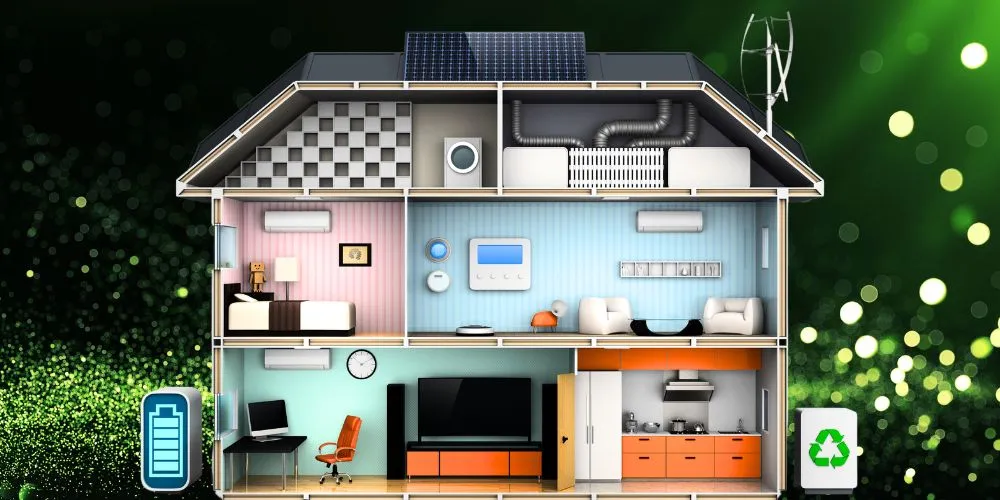In an era marked by growing environmental consciousness and the need for sustainable living, energy-efficient homes have emerged as a compelling solution. These homes prioritize conserving energy and resources, reducing both environmental impact and utility costs for homeowners. This comprehensive article delves into the world of energy-efficient homes, exploring their foundational principles, discussing their profound impact on the environment and homeowners, and highlighting the challenges and opportunities that lie ahead.
What Are Energy-Efficient Homes?
Energy-efficient homes represent a significant shift in the way we approach residential construction. They are characterized by a commitment to minimizing energy waste and reducing the environmental footprint associated with traditional homes. These homes incorporate a wide range of building techniques, cutting-edge technologies, and sustainable materials, all aimed at achieving maximum energy efficiency without compromising the quality of life for the occupants. The overarching goal of energy-efficient homes is to reduce energy consumption, lower utility costs, and decrease greenhouse gas emissions from home operations.
Principles of Energy Efficiency in Homes
Fundamental principles that guide energy-efficient home design, construction, and operation are at the heart of these homes. These principles ensure that energy efficiency is at the forefront of every decision made throughout the home’s lifecycle.
Effective Insulation
Energy-efficient homes prioritize effective insulation in walls, roofs, and floors. This insulation helps create a thermal barrier that prevents heat loss in the winter and heat gain in the summer, thus maintaining a stable and comfortable indoor temperature year-round.
High-Performance Windows
Another critical aspect is high-performance windows equipped with multiple panes, low-emissivity coatings, and gas fills to minimize heat transfer. These windows enhance thermal comfort and reduce the need for heating and cooling, resulting in energy savings.
Sealed Air Leaks
Energy-efficient homes are meticulous about sealing gaps and cracks in the building envelope. This process prevents unwanted drafts and heat loss, ensuring that the indoor environment remains comfortable and energy efficient.
Efficient Heating and Cooling Systems
Energy-efficient homes employ HVAC (Heating, Ventilation, and Air Conditioning) systems designed for efficiency to optimize energy use further. These systems consume less energy while still providing consistent and precise temperature control.
Energy-Efficient Lighting
Traditional incandescent bulbs have been replaced with energy-efficient LED and CFL (Compact Fluorescent Lamp) lighting. These lighting options consume significantly less electricity and have longer lifespans, reducing maintenance costs.
Energy-Efficient Appliances
Energy-efficient homes are equipped with ENERGY STAR-rated appliances and equipment. These appliances, such as refrigerators, washing machines, and water heaters, are designed to reduce energy consumption without sacrificing performance.
Renewable Energy Sources
Some energy-efficient homes incorporate renewable energy sources such as solar panels or wind turbines to reduce their carbon footprint further. These sources generate clean, sustainable energy that can power the home and even feed excess energy back into the grid.
Smart Home Technology
Energy-efficient homes often embrace smart home technology, including smart thermostats, lighting controls, and home automation systems. These technologies optimize energy use by adjusting settings based on occupancy, outdoor conditions, and time of day, maximizing efficiency.
Advantages of Energy-Efficient Homes
The adoption of energy-efficient practices and technologies in homes offers a myriad of advantages, both for homeowners and the environment.
Lower Utility Bills
One of the most tangible benefits for homeowners is the substantial reduction in utility bills. Energy-efficient homes consume significantly less energy, resulting in ongoing electricity, heating, and cooling cost savings. Over time, these savings can accumulate to represent a substantial return on investment.
Environmental Benefits
Energy-efficient homes have a considerably smaller carbon footprint compared to their traditional counterparts. By reducing energy consumption, they contribute to lower greenhouse gas emissions, helping to mitigate the effects of climate change and reduce the strain on natural resources.
Enhanced Comfort
Energy-efficient homes prioritize occupant comfort. Combining effective insulation, efficient heating and cooling systems, and draft prevention measures creates a more comfortable living environment throughout the year. Residents enjoy consistent temperatures and improved indoor air quality.
Increased Property Value
Energy-efficient features can enhance a home’s resale value. Homebuyers are increasingly looking for properties with lower operating costs and a commitment to environmental responsibility. As a result, energy-efficient homes can command higher prices in the real estate market.
Health Benefits
Energy-efficient homes often exhibit improved indoor air quality due to better ventilation and low-VOC (Volatile Organic Compounds) materials. This cleaner indoor environment can improve occupants’ health and well-being, potentially reducing healthcare costs.
Reduced Maintenance
Energy-efficient homes are built to high standards using durable materials. As a result, they typically require less maintenance over time than homes with less energy-efficient features. This translates into fewer repair and replacement costs for homeowners.
Applications of Energy-Efficient Homes
Energy-efficient principles and technologies can be applied across various types of homes, catering to diverse needs and preferences.
New Construction
Builders and developers increasingly incorporate energy-efficient designs and materials from the ground up. New construction homes are designed to meet or exceed stringent energy efficiency standards, ensuring long-term savings and environmental benefits for homeowners.
Retrofitting Existing Homes
Existing homes can also benefit from energy-efficient upgrades. Retrofitting involves:
- Adding insulation
- Installing energy-efficient windows
- Replacing outdated HVAC systems
- Upgrading lighting and appliances
These improvements can significantly enhance the energy performance of older homes.
Affordable Housing
Energy-efficient practices can be integrated into affordable housing projects, making energy savings accessible to a broader range of homeowners. These initiatives aim to alleviate the energy burden on low-income households while promoting sustainability.
Luxury Homes
Even luxury homes are embracing energy-efficient technologies and materials. High-end residences often incorporate cutting-edge solutions that seamlessly blend luxury living with sustainability, showcasing the versatility of energy-efficient concepts.
Environmental and Societal Impact
Energy-efficient homes have far-reaching implications for both the environment and society.
Carbon Emissions Reduction
Widespread adoption of energy-efficient homes makes a substantial contribution to reducing carbon emissions. By minimizing energy consumption, these homes play a vital role in mitigating the impact of climate change, helping to create a more sustainable future for the planet.
Resource Conservation
Energy-efficient homes significantly reduce the demand for natural resources such as fossil fuels, electricity, and water. This approach ensures the responsible use and preservation of these resources for future generations, promoting environmental sustainability.
Energy Security
Decreased energy consumption in homes enhances energy security on a broader scale. By relying less on external energy sources, communities become less vulnerable to supply disruptions, price fluctuations, and geopolitical uncertainties related to energy.
Health and Well-being
Energy-efficient homes foster healthier living environments. Improved indoor air quality, reduced exposure to pollutants, and enhanced thermal comfort contribute to occupants’ well-being and potentially reduce healthcare costs associated with respiratory illnesses and allergies.
Job Creation
The energy-efficient home sector offers substantial opportunities for job creation. Industries related to construction, renewable energy, and green technologies experience growth as demand for energy-efficient products and services continues to rise. This job creation has positive economic implications for communities.
Challenges and Future Directions
While energy-efficient homes offer numerous benefits, they also face challenges to widespread adoption.
Upfront Costs
One of the primary challenges is the higher upfront costs associated with energy-efficient features and technologies. Although these investments yield long-term savings, many homeowners may be deterred by the initial expense. To address this barrier, incentives, rebates, and financing options can help make energy-efficient upgrades more accessible.
Consumer Awareness
Many homeowners are unaware of the benefits of energy efficiency or may underestimate its financial and environmental impact. Educating consumers about the advantages of energy-efficient homes and showcasing real-world savings is crucial for increasing adoption.
Regulatory Barriers
Building codes and regulations in some regions may not fully support or incentivize the adoption of advanced energy-efficient technologies. Advocacy for updated and harmonized codes and standards is essential to remove regulatory barriers and encourage innovation.
Technology Advancements
The continuous advancement of energy-efficient technologies, materials, and construction practices is vital to driving innovation and reducing costs. Ongoing research and development efforts are needed to make energy-efficient solutions more accessible to a broader range of homeowners.
Equity and Accessibility
Ensuring that energy-efficient solutions are accessible to all socioeconomic groups is essential to promoting equitable sustainability. Efforts to aid lower-income households for energy-efficient retrofits are crucial for addressing energy poverty and reducing disparities.
Conclusion
Energy-efficient homes are a sustainable living solution that addresses pressing environmental challenges while offering homeowners financial benefits and improved quality of life. By embracing energy-efficient principles and technologies, individuals can reduce their environmental footprint, lower utility bills, and contribute to a more sustainable future. Addressing challenges related to upfront costs, consumer awareness, and regulatory barriers will be pivotal as society continues to prioritize energy efficiency and embrace the principles of sustainable living. Energy-efficient homes represent a transformative force that paves the way for a more sustainable and resilient tomorrow, benefiting individuals and the planet.










